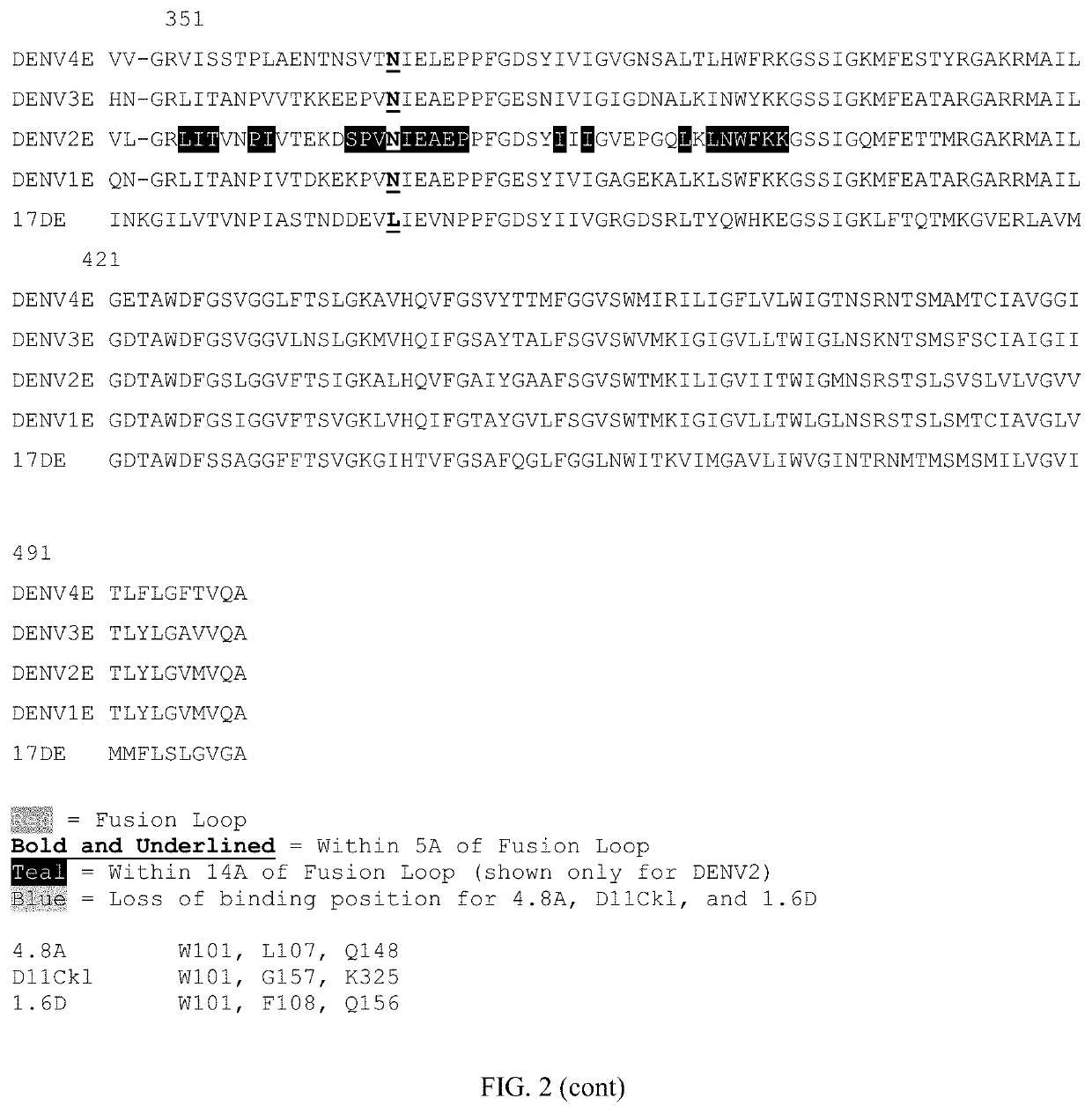Vaccines and methods for creating a vaccine for inducing immunity to all dengue virus serotypes
a technology of dengue virus and vaccine, which is applied in the field of vaccines, can solve the problems of affecting the immune response of all dengue virus serotypes, unable to control dengue virus by vaccination, and the highest risk of severe disease, and achieves enhanced all four serotypes, broad but intermediate neutralization activity, and high affinity
- Summary
- Abstract
- Description
- Claims
- Application Information
AI Technical Summary
Benefits of technology
Problems solved by technology
Method used
Image
Examples
example 1
[0066]This chimeric E protein is a useful target to modify the yellow fever 17-D vaccine, one of the most successful vaccines ever developed, for use in dengue viral vaccination. The fusion loop was identified as a target from mechanistic experiments. These antibodies do not interfere with virus-cell binding, but do inhibit the ability of virus to fuse with liposomes. There is further defined their epitopes through binding experiments with a large panel of E protein mutants. Mutations in the E protein that prevent binding of these antibodies map to locations in and near to the fusion loop.
[0067]The chimeric protein is created by substituting amino acids of yellow fever virus (YFV), in particular YFV17D, envelope protein proximal to the domain II fusion loop. As used in this invention, amino acids “proximal to” the domain II fusion loop are those amino acids which are near the domain II fusion loop of the YFV envelope protein, shown in FIG. 1(a). In one embodiment, amino acids which ...
example 2
[0088]Testing of the yellow fever virus envelope protin backbone showed the E protein tertiary and quaternary structure were sufficiently homologous to permit a neutralizing response when site-directed substitutions of DENV amino acids were placed into the YFV backbone. Research has shown that flavivrus E proteins share a very similar structure, with regions that are highly conserved over the phylum, such as the fusion protein (Zhang, et al., Structures and functions of the envelope glycoprotein in flavivrus infections. Viruses. 2017 November; 9(11):338). In fact, the structure of the flavivrus E protein contains a helical anchor, a transmembrane of two cationic helices, an eight-stranded β-barrel EI domain, a highly-concerved loop EII domain, and a globular EIII region containing anti-parallel β-stands, and some helices (Zhang, et al., Structures and functions of the envelope glycoprotein in flavivrus infections. Viruses. 2017 November; 9(11):338). Accordingly, site directed mutage...
example 3
[0090]With the goal of understanding the human antibody response in naturally occurring DENV infections, hMAbs were isolated from peripheral blood B cells obtained from patients with distinct histories of DENV infection. Three patients, 7B, 8C, and DA003, contracted DENV in geographically distinct regions, Myanmar, Jamaica, and Singapore, respectively.
[0091]The collection and use of human blood samples was approved by various institutional review boards. Three patients were identified as having recovered from DENV infection. Patient 7B had acquired DENV while traveling in Myanmar. Blood was drawn from this patient 2 years post-hospitalization, as previously described (Schieffelin, et al., Neutralizing and non-neutralizing monoclonal antibodies against dengue virus E protein derived from a naturally infected patient. Virol. J. 2010 Feb. 4; 7:28). Patient DA003 was hospitalized in Singapore and had blood drawn approximately 4 weeks post-recovery. As DENV IgG antibodies were detected, ...
PUM
| Property | Measurement | Unit |
|---|---|---|
| PMT voltage | aaaaa | aaaaa |
| PMT voltage | aaaaa | aaaaa |
| PMT voltage | aaaaa | aaaaa |
Abstract
Description
Claims
Application Information
 Login to View More
Login to View More - R&D
- Intellectual Property
- Life Sciences
- Materials
- Tech Scout
- Unparalleled Data Quality
- Higher Quality Content
- 60% Fewer Hallucinations
Browse by: Latest US Patents, China's latest patents, Technical Efficacy Thesaurus, Application Domain, Technology Topic, Popular Technical Reports.
© 2025 PatSnap. All rights reserved.Legal|Privacy policy|Modern Slavery Act Transparency Statement|Sitemap|About US| Contact US: help@patsnap.com



